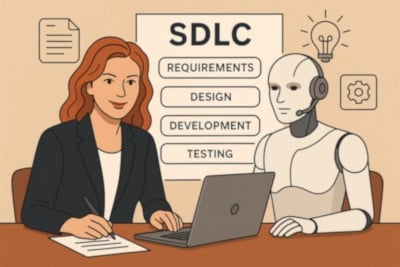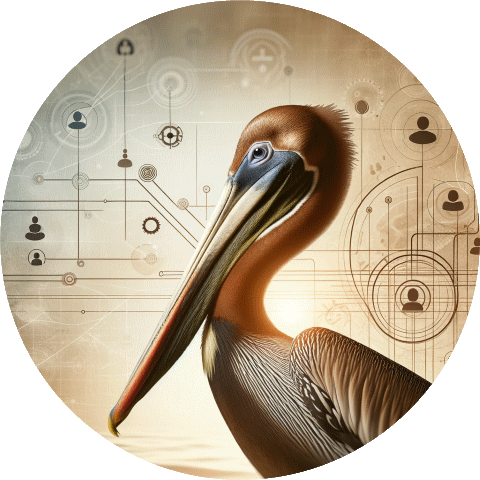The Human Touch in the Age of AI-Driven Development
Why the SDLC Still Matters — and How Consultants Can Harness AI to Deliver Faster, Smarter, and with Greater Traceability
Introduction: The Rise of the AI Developer
June 8, 2025 - 8 min read
Artificial intelligence is already reshaping the software development landscape. In many cases, what once required a team of skilled engineers can now be rapidly prototyped, generated, and even iterated by AI models. From writing clean code to suggesting architecture patterns, AI is no longer just a productivity booster — it’s becoming a core part of the development toolkit.
But here’s the truth: just because AI can build faster doesn’t mean it can build right.
The success of any technology solution, especially in complex, regulated, or high-stakes environments, still depends on a deep understanding of business needs, user context, and operational realities. That’s not something AI can infer on its own. Not yet, and likely not for a long time.
This is why structured solution delivery processes, like the System Development Life Cycle (SDLC), remain more relevant than ever. In fact, I’d argue that as AI continues to accelerate code delivery, it raises the stakes for getting the front end of the process right — discovery, planning, co-creation, and documentation — because these inputs now fuel machines that build at scale and speed.
As a technology consultant, I’ve found that working with AI like a partner, integrated into every phase of the SDLC, produces stronger, more traceable outcomes. It lets me focus on strategy and alignment while using AI to draft, iterate, and execute faster than ever before. When done well, the result is not just better documentation or quicker delivery, it's a solution that's fit for purpose, defensible under scrutiny, and aligned with real-world business goals.
In this article, I’ll share why the human element in solution design and delivery is not just surviving, it’s becoming the critical differentiator, especially for those leading complex transformation initiatives or investing in platforms that must scale confidently.
The Role of Humans in the SDLC: Not Going Away


Across every phase, from project discovery and planning, through design, configuration, testing, deployment, and eventual sunsetting, the human role is to:
Elicit needs that are often messy, conflicting, or evolving
Negotiate and align stakeholders around trade-offs
Design solutions that are not only technically sound but also operationally viable
Ensure traceability of decisions, requirements, and outcomes
Own accountability for success, especially when things don’t go as planned
No AI tool can lead a requirements workshop, navigate organizational politics, or adapt a design midstream due to a regulatory shift. These moments require context, empathy, and judgment, all deeply human capabilities.
More than ever, the SDLC isn’t about bureaucracy but clarity and credibility. When you move fast with AI, you need to move intentionally. The role of the human SDLC practitioner is not to slow things down, but to shape and guide the solution so that speed serves the right outcome.
Despite the rise of AI-driven coding tools, the core responsibilities that define successful technology delivery haven’t changed, and they still fall on human shoulders. Whether you're building internal tools, modernizing legacy platforms, or launching entirely new digital products, the software must ultimately reflect human needs, business goals, and environmental constraints. That translation from intent to execution is where humans remain indispensable.
The SDLC provides the structure for doing this well. It’s not just a process for IT; it’s a framework for strategic alignment, risk mitigation, and cross-functional clarity. It’s especially important in environments where compliance, traceability, or user safety are at stake.
AI as a Colleague, not a Replacement
The conversation around AI often drifts into extremes, either breathless optimism about full automation or defensive skepticism about its limitations. But the most effective teams I’ve seen aren’t debating whether AI will take over. They’re figuring out how to partner with it.
Think of AI as a high-performing colleague: fast, tireless, and capable of producing first drafts of everything from user stories to test scripts. But like any colleague, it needs direction, context, and oversight. Left alone, it can misinterpret the mission. Paired with an experienced human, it becomes a force multiplier.
Across the SDLC, AI can accelerate key deliverables:
During planning and discovery, it can help summarize stakeholder input or generate draft user journeys
In design, it can visualize workflows, suggest UI patterns, or highlight gaps
During testing, it can generate test cases based on requirements, simulate edge cases, or assist with traceability matrices
For deployment and documentation, it can draft SOPs, validation protocols, and end-user training guides
But it doesn’t own the process. It supports it.
This is where the consultant’s role evolves: You don’t write every word by hand anymore, but you guide the message. You don’t create every document from scratch, but you ensure they’re aligned, accurate, and audit-ready. The focus shifts from production to orchestration, and the results are often faster and better because of it.
Used well, AI becomes part of your delivery rhythm. It reduces the grunt work, shortens iteration loops, and frees you to spend more time on what only humans can do: making decisions, connecting dots, and creating clarity where others see chaos.
Augmenting, Not Automating, Discovery
Discovery is where great solutions are born, and many projects go off track before they begin. It's not just about gathering requirements; it's about uncovering intent, reconciling priorities, and translating conversations into structured plans.
This is not a job for AI alone.
AI can help summarize meeting notes, organize thoughts, and even suggest patterns based on historical data, but it can't read the room. It doesn’t know when a stakeholder is holding back, when two teams are misaligned, or when a requirement is more political than practical. Discovery is a dialogue, not a data entry task. It requires trust, curiosity, and sometimes even a bit of conflict resolution.
In my work, I've found AI most useful after the human conversation has happened. Once the context is captured, I can use AI to:
Draft a stakeholder map
Generate personas or workflow diagrams
Reframe pain points into user stories
Suggest validation scenarios or risk categories
Propose questions for follow-up interviews
But it starts with me, or someone like me, guiding the conversation and listening for what isn’t said as much as what is.
In today’s fast-paced environment, the temptation is to shortcut this step, especially when AI tools can generate plausible-looking documentation in seconds. But plausible isn’t the same as correct. If your discovery is flawed, everything downstream, no matter how well automated, will be built on shaky ground.
That’s why the most effective teams don’t outsource discovery to AI. They lead it with humans and enhance it with AI. It’s not about cutting corners. It’s about amplifying insight.
Traceability and Trust in Complex Environments
In many industries, especially those with regulatory oversight or mission-critical operations, delivering a working system isn’t enough. You must be able to prove how and why it was built the way it was. That’s where traceability becomes a business requirement, not just a best practice.
Stakeholders need confidence that:
Business and user needs were accurately captured
Requirements were addressed intentionally
Testing was linked to design inputs and risk scenarios
The final solution is fit for production use
The SDLC enables this chain of custody, from idea to implementation, and it’s where the human role becomes essential.
AI can assist with documentation and help map relationships between requirements, test cases, and acceptance criteria. But it doesn’t know the why behind a requirement. It can’t explain why a certain risk was mitigated or why a particular exception flow matters to operations. In a regulated environment, that’s the kind of detail that separates pass from fail during an audit, or trust from skepticism during a board review.
When used wisely, AI strengthens traceability:
It helps organize and tag documentation for easier retrieval
It assists in generating validation protocols or compliance checklists
It can highlight potential coverage gaps or inconsistencies
It speeds up the production of structured evidence
However, only a human can ensure that the story makes sense, that the rationale holds up, and that the solution reflects real-world conditions.
Trust is not assumed in these environments; it’s earned through clear documentation, consistent logic, and demonstrable alignment with business needs. AI is a powerful ally in maintaining that trust, but it requires human judgment and oversight to keep it on track.
AI + SDLC = Modern Consulting Done Right
The best consultants today aren’t just experts in frameworks or fluent in buzzwords; they’re pragmatists who know how to deliver results in a fast-changing landscape. They bring structure where there’s ambiguity, momentum where there’s hesitation, and clarity where complexity threatens to overwhelm.
What’s changed is the toolkit.
AI isn’t replacing the SDLC—it’s revitalizing it. It allows consultants like me to deliver with greater speed, precision, and scale without compromising the core principles that make solutions sustainable and auditable. That’s the essence of modern consulting: blending deep process expertise with emerging tools to produce outcomes that are not only faster but also better aligned and more resilient.
Here’s what modern consulting looks like today:
We still lead discovery, but we use AI to distill insights quickly and identify gaps
We still manage requirements, but we use AI to generate test cases, workflows, and design artifacts that speed up validation
We still drive stakeholder alignment, but we use AI to simulate scenarios, visualize trade-offs, and prepare tailored communications
We still own delivery, but we use AI to accelerate documentation, reduce cycle time, and maintain traceability along the way
This isn’t about cutting corners. It’s about increasing capacity while maintaining quality, and doing so with tools that can keep pace with modern expectations.
Clients don’t just want a solution that works. They want a partner who can guide the process, adapt to change, and navigate the nuances of both people and technology. That’s where AI shines when paired with human leadership and a solid delivery model.
Final Thoughts: The Path Forward
AI is no longer a future trend. It’s here, embedded in the way we work, and it’s changing how software is built. But while the tools have evolved, the principles behind successful delivery haven’t.
Solutions still need to be grounded in real business needs, designed with users in mind, and able to withstand scrutiny, whether from regulators, executives, or customers. That’s where structured processes like the SDLC remain essential and where experienced humans remain irreplaceable.
The path forward isn’t about resisting AI or clinging to legacy methods. It’s about leading with intent. It’s about using AI as part of a disciplined, human-centered approach to delivering outcomes that are traceable, scalable, and genuinely fit for purpose.
That’s what I focus on every day as a consultant: bringing the best of both worlds — process and possibility — to every engagement.
